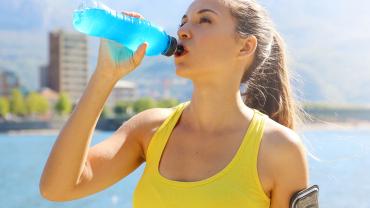
Overhydration is a serious concern that is often overlooked, which can result in complications as dangerous and deadly as those of dehydration. Overhydration can result in hyponatremia, in which the concentration of sodium has been diluted by too much water. This condition can lead to tissue swelling, weakness, dizziness, confusion, headache, nausea, and/or vomiting. Hyponatremia may also contribute to muscle cramping (painful, involuntary muscle contractions) during and/or after exercise, as pure water dilutes the electrolyte concentration in the body and doesn’t replace what is lost during sweating.
The body’s primary electrolytes include the major minerals sodium, chloride, potassium, magnesium, and calcium. Electrolytes are essential for our survival, as they regulate a variety of biochemical processes integral to maintaining cellular homeostasis and proper physiological function, one of which is muscle contraction and relaxation. Effects of an imbalance in any one of these electrolytes can be seen in numerous organ systems.
In a recent study published this March in the Journal of the International Society of Sports Nutrition, conducted at Edith Cowan University’s School of Medical and Health Sciences, ingestion of oral rehydration solutions (i.e., electrolyte mixture) during exercise decreased exercise-associated muscle cramp (EAMC) susceptibility compared to plain spring water. In this small crossover study, 10 healthy young men who regularly participated in moderate exercise two to three times per week ingested either spring water or the electrolyte solution during and after a 40- to 60-minute downhill run (DHR) in the heat to lose 1.5% to 2% body mass.
Researchers in this study electrically induced muscle cramps in the men’s calves and measured threshold frequency (TF). The lower the frequency required, the more prone to muscle cramps and vice versa. The results showed that TF values were significantly different between those men who consumed plain spring water versus those men who consumed the oral rehydration solution. A higher TF was required to induce cramps in the electrolyte group, but it was decreased in the plain water group, indicating that muscles are less likely to cramp by drinking electrolyte water. There were also significant decreases in serum sodium and chloride concentrations in the group of men who ingested spring water immediately after exercise.
Results from the present study suggest that electrolyte repletion may be an effective and relatively inexpensive way to reduce susceptibility to exercise-induced muscle cramping, particularly for patients who perform moderate-to-intense exercise on a weekly basis.
Electrolyte powders are easy and convenient, and they can be easily mixed in water and used before, during, and/or after workouts to support optimal intracellular and extracellular electrolyte balance, especially for athletes. Electrolyte powders or drinks that are high in sugar, artificial colors, sweeteners, and flavoring agents should be avoided. Instead, mineral forms of electrolytes should be chosen that are more bioavailable. For instance, chelated forms of electrolytes, such as magnesium malate and potassium aspartate, should be chosen, along with formulas that use natural sweeteners, such as stevia leaf extract. Electrolyte formulas that contain D-ribose and taurine may also assist in healthy cardiac function, exercise recovery, energy production, and osmoregulation.
By Caitlin H. Higgins, MS, CNS, LDN